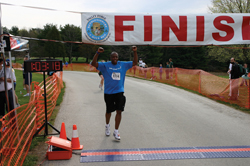Running for their lives
|
Running, like all exercise, is powerful medicine. In fact, the American Heart Association reports that active people experience more emotional, cognitive and physical benefits than sedentary people. But does running make sense for the homeless, a population understandably much more concerned with finding food and shelter than a fitness routine? Temple University researchers are hoping to find out. Jeremy Jordan, an avid runner and assistant professor of sport and recreation management at Temple’s School of Tourism and Hospitality Management, is working with Back on my Feet, a Philadelphia-based non-profit that’s using running as a way to build confidence, strength, self-esteem and independence in the homeless population. |
Audiocast
|
|
Jordan and his students want to determine just how running can motivate and shape the lives of the homeless. They’re also studying the impact of a running program on smoking rates, which can be as high as 70 percent among persons who are homeless. Anne Mahlum came up with the idea for Back on My Feet two years ago when, during her morning run, she began to befriend the homeless men she would pass at a local shelter. “Running is one of the most empowering activities there is — because there is no end. There is always another mile, another road, another right turn,” said Mahlum. “It has taught me so much about life, especially the simple notion that to get anywhere, you have to take it one step at a time.” |
|
 Photo courtesy Back on My Feet
Connie, a Back on My Feet participant, completes his first race at the Revolutionary 5-Mile Run held in April at Valley Forge National Historic Park. |
Today, working with seven Philadelphia shelters as well as a small army of volunteers, Back on My Feet organizes running teams of 10-25 people who take three morning runs each week for six months. The teams also meet monthly to discuss upcoming runs and future plans. Meetings often feature talks from experts at Temple and Jefferson Hospitals on health, nutrition and physical fitness. While attending the monthly team meetings, Jordan has witnessed individual runners transformed and running teams evolve into mini-communities and support networks. “Being part of a community hopefully leads to sustained physical activity for the folks that are in Back on my Feet,” he said. |
|
The research study, lasting 18 months, will track participants from when they start to when they graduate from the program and are out living on their own and immersed back into the community. Jordan and his students collect the data for their research via questionnaires. The information is then analyzed to determine what and when changes occur in the runners related to involvement, attitudes, self-esteem, and health behaviors such as nutrition, alcohol, drug use and smoking. Another part of the study will look at the impact of physical activity on smoking cessation. “We want to understand what types of changes take place both physiologically in terms of attitudes and self esteem as well as what triggers these changes, including how involvement in Back on My Feet acts as a catalyst,” Jordan said. Claudel “Fifty” Edwards, who has been in the program for six months, said that it’s helped him in regaining his stamina and focus. “It’s very encouraging to get out there and run, plus I’ve lost up to 35 pounds. I want to find housing and just get healthier.” After spending two months in the Back on My Feet program, members qualify to be part of the Next Steps program. Next Steps consists of educational classes, job training and placement. After six months in the program, a member can apply for a grant to help with apartment, education or job-related expenses. Darius Turner, in the program for five months, including Next Steps, said that it’s helped build his self-esteem and strength. He also reports having more courage now. A high percentage of Back on My Feet members smoke but want to quit. Preliminary findings from Jordan and his team show that 63 percent have quit or suppressed their smoking. They’ve also found that of the current 148 Back on My Feet runners, 23 have obtained housing, 35 have secured jobs, 25 are in job training programs or school, and 73 have attended one of three required financial literacy classes. In addition, there’s been an 84 percent increase in runners whose self-esteem has improved; an 88 percent increase in runners who have become more productive in their daily lives; a 90 percent increase in runners who are more excited about their future; and a 96 percent increase in runners’ self-discipline. “I guess simply put, Back on My Feet establishes that somebody cares, and I think for a lot of the members they have not had that,” said Jordan. All funding for Back on My Feet comes from donations, grants and corporate sponsorships. Other researchers on the team are Daniel Funk, a professor at Griffith University in Australia, and Brad Collins and Jennifer Ibrahim, both public health professors at Temple’s College of Health Professions. To learn more about Temple’s work with Back on My Feet, visit http://backonmyfeet.org/main/areas/about.us/results.html. — Eryn Jelesiewicz and Elizabeth Connolly |
|